Treating War Victims Part1- Explosive devices
“A Learning experience”
Part1- Explosive devices, Explosions and Injuries
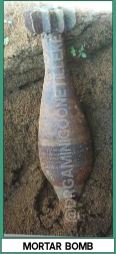
“As is your sort of mind, so is your sort of search; you will find what you desire” – Robert Browning
Explosions, the use of explosive devices and the injuries they cause were not a subject of discussion in Sri Lanka until the onset of the North- East conflict in 1983. During my days at the Medical School in the late 1960’s and even afterwards while training to be a Surgeon this was not a subject that was given any importance as such injuries were hardly seen in our hospitals.
I received my appointment as the Surgeon of the Base Hospital, Polonnaruwa in January 1982. In July 1983, a landmine was exploded by terrorists in the Northern city of Jaffna in Sri Lanka. This was not only the first landmine explosion in Sri Lanka, but an explosion of a conflict that lasted for thirty long years causing death and injury to many in addition to a multitude of other issues.
The Eastern Province bordering Polonnaruwa was relatively calm from 1983 to 1985. But pressure was building up gradually till one morning in July 1985 when the terrorists blew up an Army jeep carrying six soldiers by detonating a landmine as it passed over the mine. That was at a place called Punani bordering the Eastern Province. The soldiers injured in the landmine blast were admitted to my ward that morning. As the only surgeon in that Hospital it was my duty to attend to the injured.
This was my first exposure to blast injuries. Needless to say the injuries were revolting, horrific and gruesome. I could not believe that man can inflict such acts of barbarism against another. It is only then that I realized that this is what is referred to as Terrorism which is defined as “the unlawful acts of violence to create a general climate of fear in a population to achieve a political goal”. The victims were both military and civilian.
As the only surgeon in that hospital, it was my bounden duty to treat the injured to the best of my ability with the limited resources that were available. That was the first explosion, but not the last and many more victims were to follow over the ensuing years after being injured not only by landmines but by a whole variety of lethal explosive devices.
In view of the casualties from the Eastern Front and the areas of the Polonnaruwa district bordering the Eastern Province being admitted to the Base Hospital, Polonnaruwa, this became a centre for treating the injured Military personnel and the civilians who were the target of the terrorists on and off. I had to perform the dual role of being a Civilian and a Military Surgeon.
Explosions are associated with extensive damage and destruction of property with severe injury and death of people at the site of the explosion and in the vicinity. The extent of damage caused will obviously depend on various factors such as the type and amount of explosive, the site and also the explosive device used among others.



In view of the conflict in the North- East of Sri Lanka and the casualties arising from the conflict in the East being admitted to The Base Hospital, Polonnaruwa we had to prepare ourselves to receive and treat the wounded effectively at the hospital. Thus we had to learn many aspects related to explosions such as:
- What are explosives?
- What are the explosive devices?
- How does an explosion cause injury?
- The principles in managing these injuries
Since my knowledge on this subject was sparse, I had to read articles in books, journals and other literature related to these aspects on how the victims of explosions were treated in conflicts throughout the world. I also had to impart the knowledge that I gathered to my staff in the hospital so that we could function effectively as a team.
The application of the appropriate principles in managing the victims of explosive devices was of paramount importance to reduce their morbidity and mortality. I very quickly learnt that the techniques used are quite different to those used in managing the common injuries that we see in civilian practice. This is primarily as a result of the mechanism of injury caused by the blast wave and the transfer of energy from high velocity shrapnel of the explosive devices. During this period I was able to treat and save the lives of many armed forces personnel fighting a ruthless terrorist group and at the same time gathered tremendous experience in managing the victims of explosions.
Living in an era where explosions can occur unexpectedly at anytime and anywhere like the “Easter Bombing Spree” in Sri Lanka, it is prudent for every citizen to have a basic understanding about explosions. Injuries from explosions are surrounded by mystery for many. It was so for me as well, but now having treated many a victim of explosive devices it is not a mystery for me anymore. It is my earnest desire to share my experiences in managing victims of explosive devices with the readers of this blog so that the causation of these horrendous injuries will not be a mystery for them as well anymore!
What are Explosives

Explosives are substances which, when detonated, are very rapidly converted into large volumes of gases. When the explosion is confined by some form of bomb or shell casing, the pressure will rupture the casing, imparting high velocity to the resulting fragments. These fragments vary in size and weight from 1 to 100 gm. or more and, whether they be from conventional weapons or home-made bombs packed with nuts, bolts, screws, ball-bearings or other contents, all the fragments are projected initially at very high velocities of the order 300 – 1800 m/s ( 1000 – 6000ft/s ). They are usually irregularly shaped and therefore their velocities soon decrease. Nevertheless, all fragments from any form of explosive device must be regarded as high velocity missiles where the velocity exceeds 300 m/s.
Explosive Devices
The Explosive devices were of various types. Some were conventional, while the others were improvised by the terrorists. These were less costly but equally effective. The various types of explosive devices are
- Mines – Antitank mines, Antipersonnel mines, Sea mines, Claymore mines. (Mine injuries will be dealt with in the next post)
- Bombs
- Shells & Rockets – Artillery shells, Mortar shells
- Grenades / Rocket Propelled Grenades
- Improvised explosive devices – Booby- traps.
These are designed to explode when a person opens for example a door, picks up or handles a particular object.
- Un-exploded ordnance (UXO)
Missiles, rockets, grenades and other explosives that fail to explode upon impact are un-exploded ordnances. Most of these may remain active for many years after deployment.

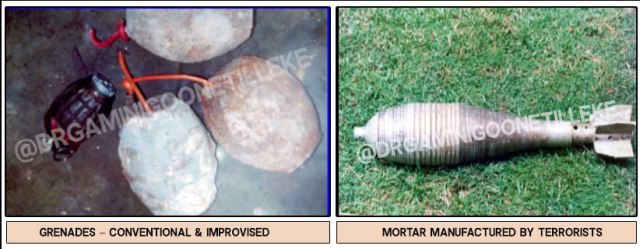


Injuries
A WORD OF CAUTION – some of the photos displayed may be gruesome and revolting. This could not be avoided as it is my intention to give a true picture of the injuries caused by explosions whether in the war front or due to terrorism.
Explosive devices cause injury by
- Thermal effects (burns) due to the heat generated at the time of explosion. These burns are of two types:
- Flash burn – caused by the flash of the explosion. These are usually superficial burns affecting the exposed parts of the body such as the face and arms. These can be treated conservatively
- Flame burn – due to the clothing catching fire. These are deep burns. The victims were admitted in a state of shock and as such needed active resuscitation with replacement of fluid.
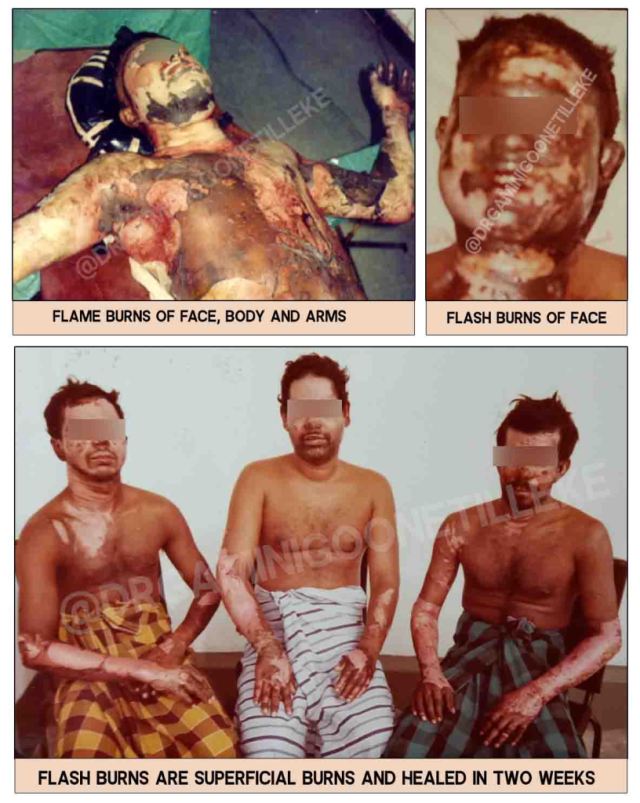
- Injury resulting from fragments (shrapnel)
- These include nuts, nails, bolts and steel pellets incorporated in explosive devices or due to fragmented pieces of metal from devices like grenades, bombs and shells
- Hard objects caught up in the blast wave like pieces of metal, glass, wood etc. from the scene of the explosion. These fragments travel at high velocity and produce severe injury to body tissues as a result of the following mechanisms.
Mechanism of Injury by Shrapnel
Temporary cavitation – as the penetrating fragment releases its energy, it is absorbed by the local tissues. These tissues accelerate violently forwards and outwards. Due to their inertia the tissues take a perceptible time to get moving and then their momentum causes them to continue to move after the passage of the fragment. Thus a large cavity is created which is approximately 30-40 times the diameter of the fragment. This cavity has a sub-atmospheric pressure and debris from outside is sucked into the cavity through the entrance and exit holes caused by the fragment. This cavity rapidly collapses over a few milliseconds in a pulsatile fashion, leaving a macerated track which is called the permanent cavity.

- Shock wave – whilst forcing a track through the solid tissues the fragment compresses the medium in front of it and this region of compression moves away as a shock wave of spherical form. These shock waves can cause damage at a considerable distance from the wound track. Solid tissues are very susceptible to their transmission and shock waves can be transmitted along fluid-filled tubes such as arteries and veins, to cause damage at a distance.
- Laceration & crushing – as the fragment penetrates, the tissues are crushed and forced apart. Vital organs or major blood vessels can be injured directly with serious consequences
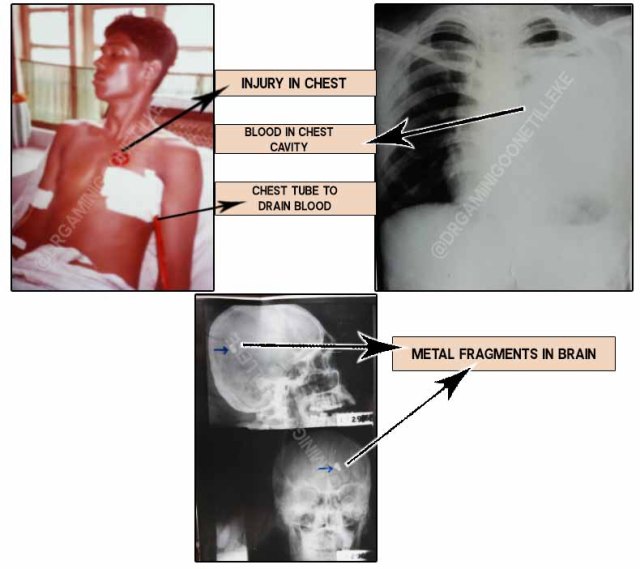
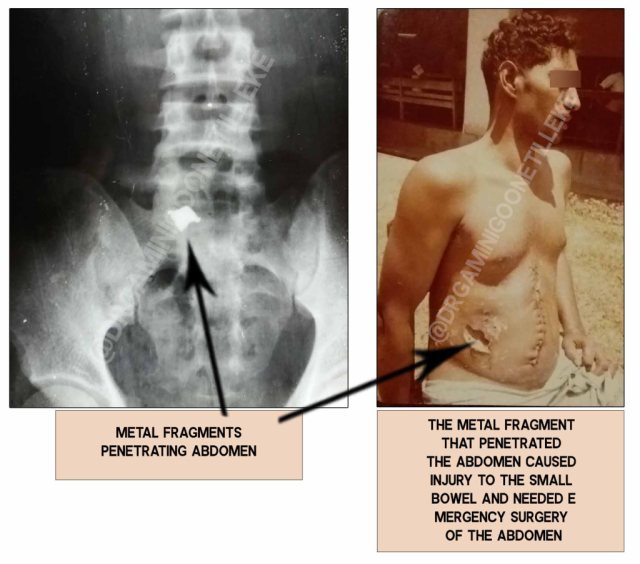


The severe effects of an explosion are due to the blast wave. This consists of a wave of positive pressure wave which lasts only for a few m. sec. This is followed by a negative pressure wave which lasts longer. It is the positive pressure wave that causes most of the damage. This wave can cut through the body causing fatal injuries, amputation of limbs and even decapitation.
The blast wave also damages air containing organs such as the ear, lung and bowel.
- The ear can be affected as the ear drum can rupture causing deafness.
- In the lung it produces a syndrome called the shock lung. These patients have difficulty in breathing, blood stained froth at the mouth and severe swelling of the lung tissue with accumulation of fluid called pulmonary oedema. These patients need emergency care in an Intensive Care Unit with ventilator support.

- The bowel can rupture causing leakage of bowel contents into the abdominal cavity resulting in an infection called peritonitis. This can occur without any external injury to the abdominal wall.

- Indirect injury– Behind the blast wave also called the shock front comes the blast wind which is the movement of the air itself which spreads out rapidly from the epicenter of the blast. The dynamic force of the blast wind can be so great as to carry the patient along with it. This results in impact injuries. In extreme cases amputations, decapitations etc. were also seen.
INJURIES CAUSED BY THE BLAST WIND

Victim of a Bomb Blast. He was thrown out and sustained blunt trauma to the abdomen and was admitted with signs of bleeding into the abdominal cavity. He had emergency surgery of the abdomen. There was a large amount of blood in the abdominal cavity due to rupture of his spleen. Blood transfusion and the removal of the ruptured spleen was life saving.
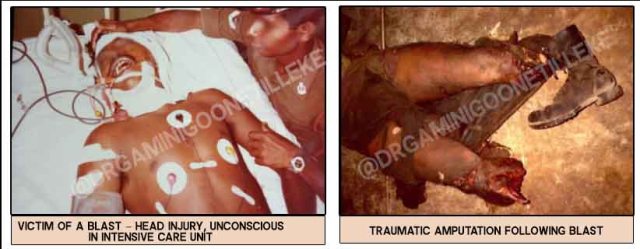
Explosions can produce a large number of casualties placing a great strain on the resources of hospitals attending to such casualties. The pattern of casualties varies from one incident to another.
The mortality for explosive blast injuries is high. There are many reasons for this high mortality. The first is the severity of the wounding which is due to the blast wave and transfer of energy to body tissues and organs from shrapnel at high velocity. The second is inadequate first aid at the site of the explosion especially when large numbers are injured. The third factor is delay in medical attention. Such delays can be avoided if there is a meticulous Disaster Plan which is executed well. Finally faulty surgical techniques in treating these victims can also contribute to the high mortality. Such patients must be treated according to principles appropriate for the management of the war wounded.
Adherence to these principles complemented by skilled first aid, rapid evacuation of the casualties to appropriate hospitals, a plentiful supply of blood, adequate facilities and staff in the Surgical Centre should on the whole give good results.
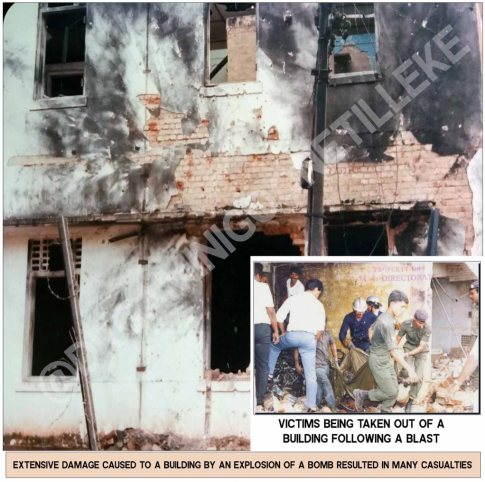
Dear Reader, You might want to read the second part of this story in which I share from my learning experience by treating war victims : ‘TREATING WAR VICTIMS PART 2 – LANDMINES’
Please feel free to share story this with your friends :
0 thoughts on “Treating War Victims Part1- Explosive devices”
Reblogged this on drshums.
Great insight into explosives and injuries caused by them!
Dear Doctor, You will be blessed for what you have done for the society.
Definitely a must-read! So well put. Very interesting to read about the mechanisms of injury. Never would I be able to find such a comprehensively written blog post like this! Looking forward to more sir!
Dear Nethmini
Thank you
I had to learn the basics and now I am trying to educate and Inspire the younger generation
Best wishes
Gamini Goonetilleke
What an experience in saving lives and passing on information to laymen like us and also imparting knowledge to young doctors. I learnt a lot about bomb blast injuries after reading your article. Excellent scientific explanations explained in simple language. You are a servant of God sent you heal the people with your medical knowledge and specialised treatment skills. Very proud to advertise that you are regaled to me through your wife Shelndra. Niran Samarasekera : email: ceronus@bigpond.com
Dear Niran
Thank you for your comment. I am really happy that am able to educate not only budding doctors but also others. My stories are to educate and Inspire. If I am able to achieve that goal then the time spent in writing stories is fully worth.
Best wishes
Gamini
Learned a lot about some military hardware. It was so difficult to see the pictures of the injuries and I wondered how a surgeon manages his emotions when he sees it in real life and in emergences.
Well this was yet another breathtaking and challenging read. Only one who went through such trauma and experienced the real mean of terror can write in such a way. The writer must be highly commended in demonstrating these challenging issues.
AMS